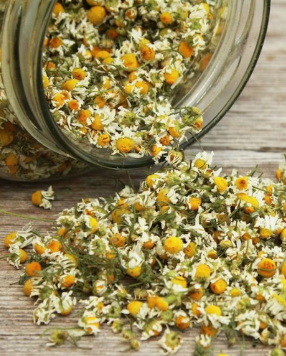Chamomile is an herb that comes from the Asteraceae family (more commonly known as the daisy family). Chamomile has been used for many years, even in ancient civilizations, for its therapeutic properties.
The 2 chamomile varieties that we often hear about in the herbal or aromatherapy world are Roman Chamomile and German Chamomile.
One of the most common ways to consume chamomile is to make chamomile tea! How can you use chamomile tea to benefit your health? Let’s take a look at the amazing chamomile tea benefits you can get from just drinking or applying the tea:
12 Health Benefits of Chamomile Tea
May Encourage a Better Nights Sleep
Chamomile tea has long been used before bedtime to help relax and calm before settling in for the night.
Chamomile is said to contain flavonoids that bind in the brain that can promote sleepiness and may help to reduce insomnia.
I know drinking tea to relax before bed has always helped me (I grew up drinking Sleepy Time Tea!) so adding chamomile to your cup can help even more!
Supports Digestive Health
Chamomile is very gentle and has also showed promise in being used as a digestive relaxant and to help aid in digestion.
If you suffer from frequent upset stomach after eating or from symptoms like nausea, diarrhea, gas or even from irritable bowel syndrome, try adding 2-3 cups of chamomile tea to your day to see if it helps to ease your symptoms.
Supports Emotional Health
Just like roman chamomile essential oil can be used in times of emotional stress, one of the benefits of chamomile tea is that it can help support your emotional health.
Like I mentioned above, drinking herbal tea in general is great for relaxation, but chamomile tea in particular can help promote that feeling of calm.
Set aside some time each morning to drink a cup of chamomile tea before meditation or before bed to help you release the day’s stress.
You can also add a pot of fresh chamomile tea to your bath and soak away your stresses.
Supports a Healthy Immune System
We are all looking for more natural ways to deal with the symptoms of viral infection such as colds or flus. And another chamomile tea benefit is that it supports your immune system- which can help you fight off sickness more effectively.
In one study, drinking chamomile tea was associated with higher levels of hippurate and glycine, both of which have been associated with antibacterial activity.
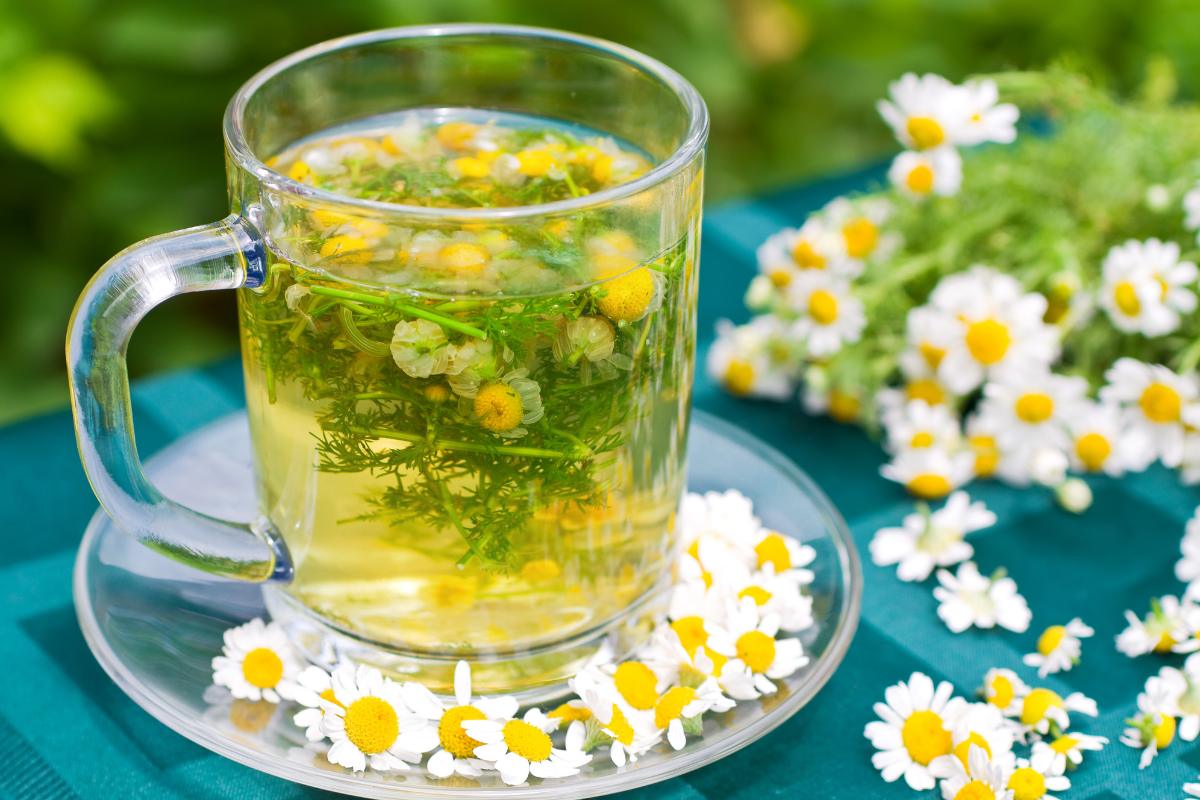
Supports Healthy Skin
Chamomile has been used for centuries to promote skin health, healing, and help wounds to heal.
Chamomile tea has astringent properties and is a strong soother, so try using it on skin conditions like eczema, diaper rash, bruises, or sunburn.
Chamomile also contains antioxidants that may help your skin look younger longer!
You can also use the essential oil version of chamomile or create an infused oil with the flowers to create skin creams or oils and get these same benefits.
May Help Regulate Blood Sugar
Some studies have shown that chamomile tea might help to lower blood sugar levels.
In this study, participants who drank chamomile tea 3 times per day, with meals showed beneficial effects on glycemic control.
If you have trouble with blood sugar spikes, try adding some tea to your meals and see what happens.
May Help Reduce Acne
The anti inflammatory properties and antioxidants in chamomile tea may also help those who suffer from acne.
If you have blemishes try soaking a cotton pad in chamomile tea and applying them directly to your problem areas. Allow these pads to sit for 5-10 minutes.
The healing properties may also help to heal past acne scars.
May Reduce Presence of Dandruff
We’ve already talked about the benefits chamomile tea can have of your skin, and your scalp is no different.
Try adding chamomile tea to your showering routine, simply by rinsing your hair with a cup of lukewarm tea after cleansing.
You can rinse or allow the tea to dry in your hair.
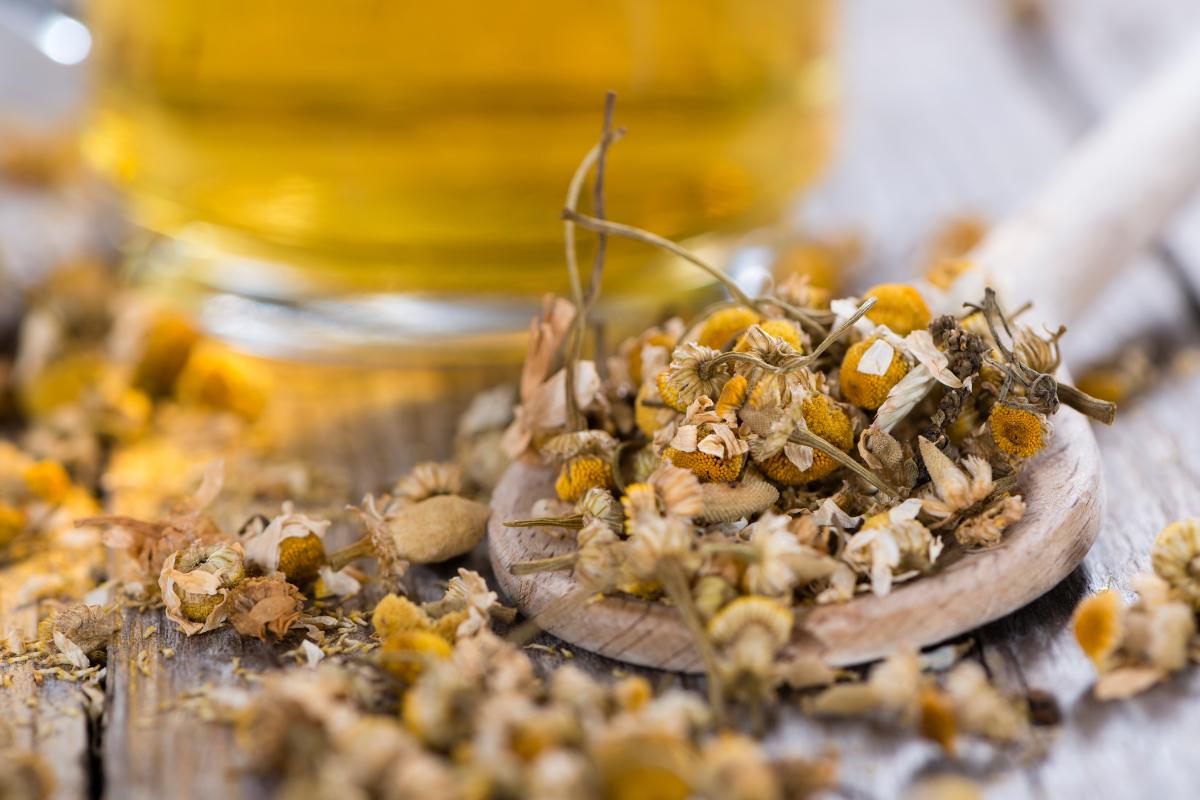
Easing and Soothing Colicky Babies
Chamomile is so gentle even babies can use it!
It is a popular choice for parents to help calm colicky babies. Many instances of colic can be attributed to the stomach and digestion, and as I mentioned above chamomile can be used as a digestive relaxant.
Talk to your pediatrician to see if chamomile tea can help calm your colicky newborn.
May Help Reduce Muscle Spasms
Chamomile has also been said to have antispasmodic and pain relieving properties.
These properties can help relieve muscle spasms and menstrual cramps associated with PMS.
May Reduce Inflammation
Chamomile flowers contain rich amounts of azulene, which is a volatile oil that can serve as anti inflammatory agents.
This means it may help reduce the pain and inflammation associated with conditions such as arthritis.
As we talked about already, it can also soothe skin inflammation as well, so try it on rashes or sunburns to soothe those conditions.
Supports a Healthy Nervous Systems
This should come as no surprise, since we’ve been talking about the soothing, antispasmodic properties of chamomile all along.
Your body is complex and all the systems work together. For example when you are under stress, you may experience digestive upset.
So the calming and sedative nature of chamomile can benefit your entire nervous system- from the emotional side to the physical side.
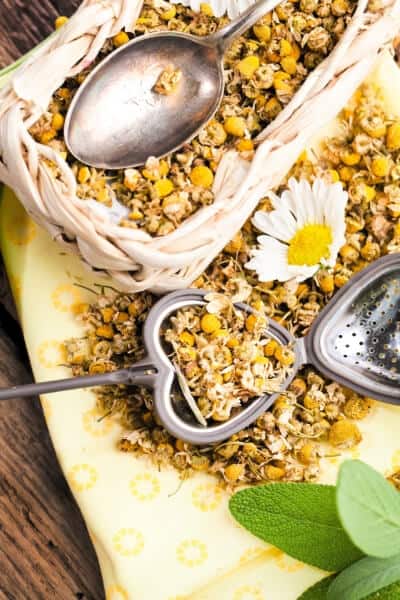
How to Make Chamomile Tea
Making a cup of chamomile tea is simple, all you need is:
1 tsp of dried chamomile flowers OR 2 tsp of fresh chamomile flowers
Place the flowers in a mug and pour 1 cup of boiling water over top.
Steep for 10-15 minutes
Strain out the flowers
Add honey if you wish, or drink as it.
You can also add this tea to bath water, use it in a compress, or apply it directly to the skin.
If you don’t have fresh flowers, you can also purchase an organic chamomile tea, like this one.
Who Shouldn’t Drink Chamomile Tea?
If you are allergic to plants in the Asteraceae family you should not drink or use chamomile tea.
If you notice signs of an allergic reaction, such as itchy eyes, runny nose, scratchy throat, or other side effects, discontinue use.
In the end, adding a few cups of chamomile tea to your day can help you in so many ways. And there’s nothing to lose by doing it- so try a cup and see what benefits you feel from drinking chamomile tea!
What to Do with Chamomile Flowers
Here are ten pretty and useful ways to use chamomile flowers!
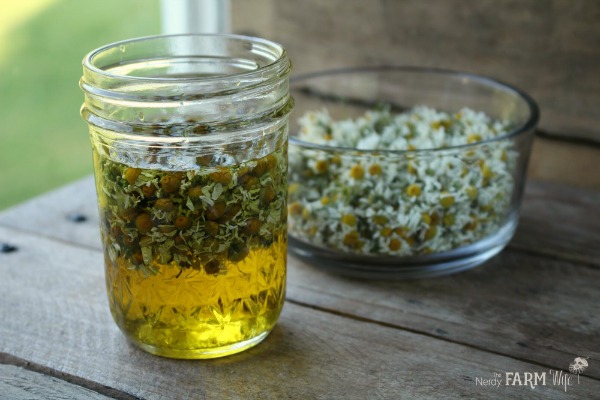
1. Chamomile Infused Oil
Chamomile infused oil can be used to make lotion bars, lip balm, soap, deodorant, body butter, and more!
To make the infused oil:
- Fill a small canning or other heatproof jar about half way with dried chamomile blossoms. (It’s fine if some of the leaves and stems get in too.)
- Pour oil over the flowers until the jar is almost full, leaving a little bit of room for expansion and shaking.
- If you’re going to use the oil for soap, try infusing olive oil. Sunflower is a great choice for lip balms, lotions, etc. or you could choose something like rice bran, apricot kernel, or sweet almond oil. (I love using the organic oils from Mountain Rose Herbs for my skincare products.)
- At this point, you can infuse the slow way (my favorite method), or if you’re in a hurry, the quicker way. You’ll also need to use the quick method if you’re infusing something that’s solid at room temperature, such as coconut oil.
To infuse the slow way, just put a lid on your jar of herbs and oils and tuck them away in a cabinet for at least four weeks, shaking occasionally.
For a quicker infusion, keep the jar uncovered, set it down into a saucepan containing a few inches of water and let this heat over a low burner for around two hours. Remove from heat and use a portion of it right away for a recipe. Then top the jar off with fresh oil, cover it with a lid and let it infuse the slow way for a few weeks longer, for use in future projects.
Once the oil is infused to your satisfaction, it can be strained and stored for around 9 months to a year, or until you’re ready to use it.

2. Chamomile & Sweet Orange Deodorant
I made this deodorant using chamomile infused coconut oil, and scented it with sweet orange and frankincense essential oils.
You’ll also need:
- shea or mango butter
- beeswax
- arrowroot powder
- white kaolin clay (or baking soda)
Find the full recipe at:

3. Chamomile Lip Balm (with printable labels)
These lip balms are perfect for smoothing over rough, dry, or chapped lips. I also have some labels that you can print out for your lip balms!
You’ll need:
- chamomile infused oil
- castor oil (or more infused oil)
- shea or mango butter
- beeswax (or candelilla wax for vegan version)
Find the recipe & the printable labels at:
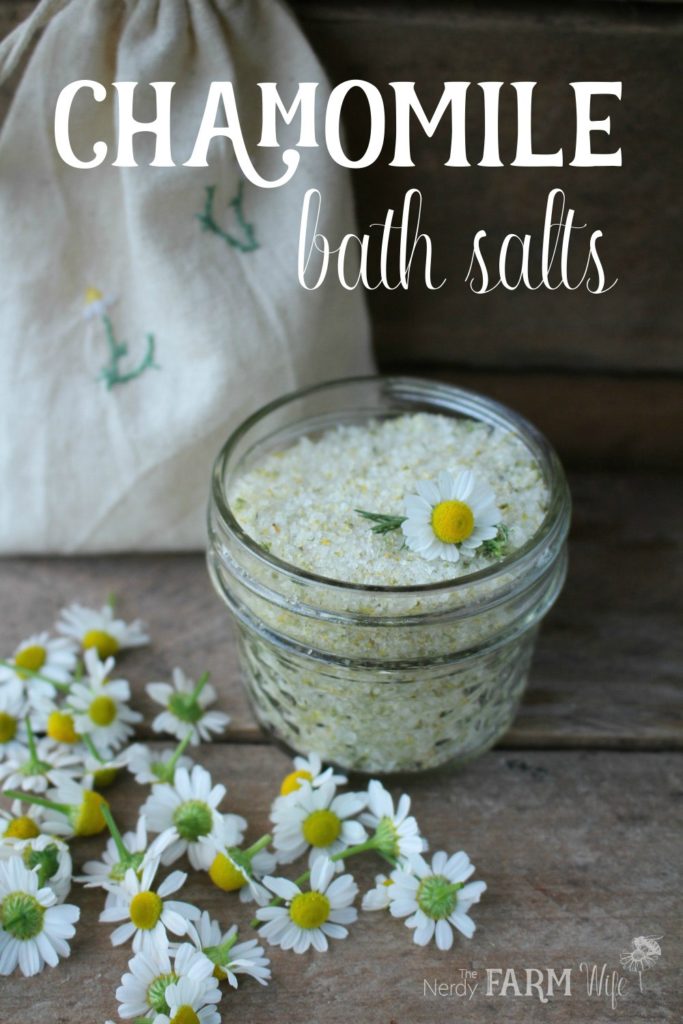
4. Bath Salts or Soaks
It’s easy to make pretty chamomile colored and scented bath salt – you just need fresh chamomile flowers and any type of salt.
If I’m using the finished salt to make bath bombs (as in the next project), I use sea salt. For bath soaks, Epsom salt is a good choice too.
For the full recipe, visit: Chamomile Bath Salts
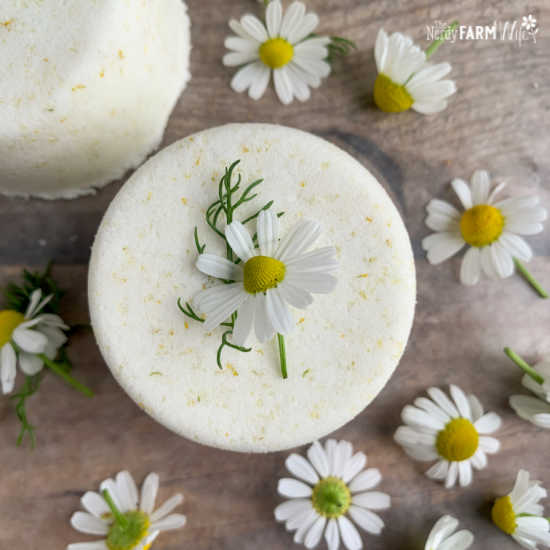
5. Chamomile Bath Bombs
Use the chamomile salt from above to make these bath bombs.
Ingredients needed:
- 1 1/2 cups baking soda
- 3/4 cup citric acid
- 1/2 cup chamomile salt
- 2 tbsp chamomile infused coconut or other oil
- 20 to 25 drops lavender essential oil, optional
- Witch hazel in a spray bottle
- 1/3 or 1/2 cup measuring cup for a mold
How to make:
- Stir together the baking soda, citric acid, and chamomile salt together in a medium mixing bowl, working out any clumps with your fingers.
- In a separate bowl, combine the infused chamomile coconut oil (melted) with the lavender essential oil, if using.
- Slowly drizzle the melted oil into the combined dry ingredients while stirring with a whisk, then use your fingers to break up any remaining clumps.
- Pick up a handful of mixture and squeeze it into a ball shape with your hand.
- If it crumbles, spray 2 or 3 spritzes of witch hazel into the mixture while stirring, then check again.
- When the mixture holds together easily without crumbling, it’s ready to turn into bath bombs!
- Fill the measuring cup with the bath bomb mixture, pressing firmly as you pack it in, then turn out the bath bomb from the measuring cup and onto a sheet of wax paper.
- Allow the bath bombs to air-dry for several hours, then wrap in airtight packaging.
(For more natural bath soak and bath bomb ideas, be sure to also check out my Natural Bath Care Package!)
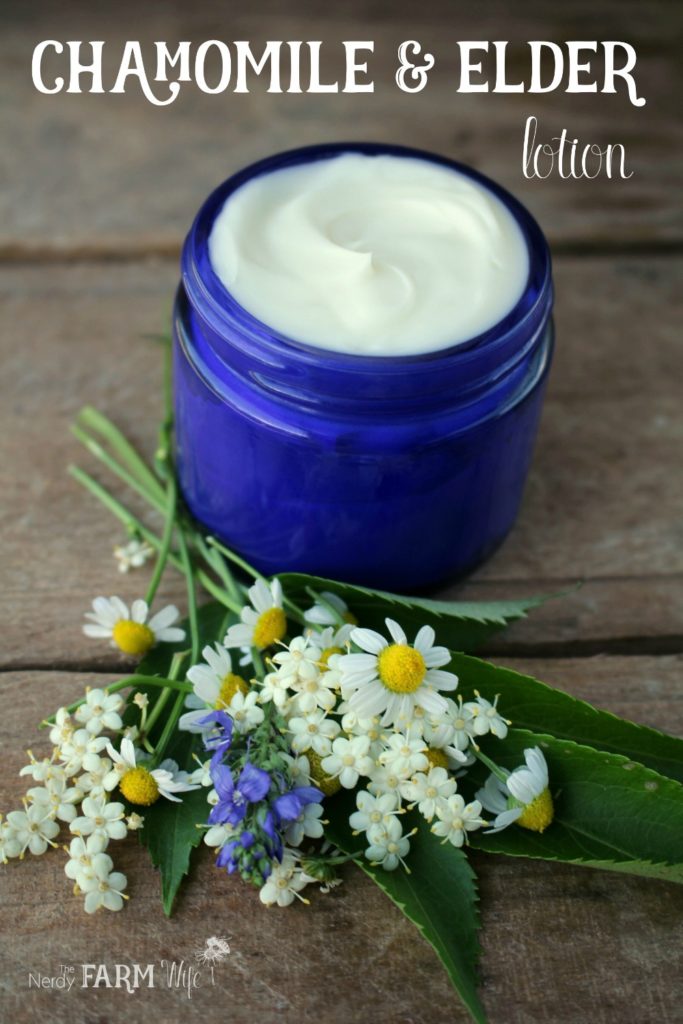 Chamomile has healing and anti-inflammatory properties, making it perfect to use in lotions and creams for your skin!
Chamomile has healing and anti-inflammatory properties, making it perfect to use in lotions and creams for your skin! 6. Use the Flowers in Lotion Recipes
Chamomile infused oil can replace plain oil in lotion and cream recipes.
For this recipe, I also infused the oil with elderflowers and marshmallow root for their ability to soothe inflammation and irritation.
It’s a gentle lotion, perfect for those with extra sensitive skin.
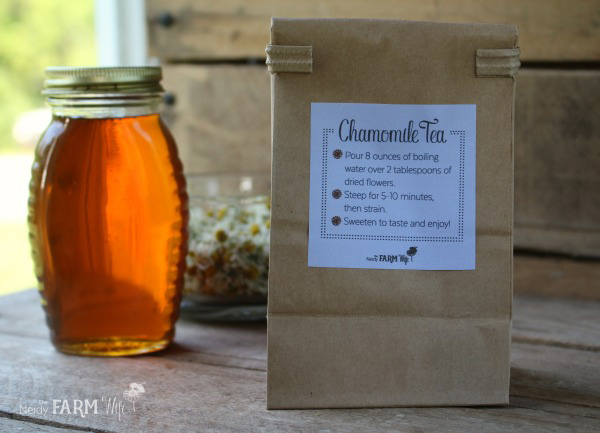 Chamomile tea is a mild sedative that promotes relaxation and is used to treat everything from upset tummies to sore throats to mild anxiety.
Chamomile tea is a mild sedative that promotes relaxation and is used to treat everything from upset tummies to sore throats to mild anxiety. 7. Chamomile Tea + Labels
While you can buy chamomile tea bags from the store, chamomile tea is so easy to make at home too!
Just gather fresh flower heads and spread them out in a single layer on a clean dish towel until completely dry, then package in brown paper bags or another container.
Here’s how you make a cup of chamomile tea:
- Pour 8 ounces simmering hot water over 2 tablespoons dried chamomile flowers.
- Steep for 5 to 10 minutes, then strain.
- Sweeten to taste with honey and enjoy!
Be sure not to steep chamomile for too long, since it can get bitter with extended steeping time.
I’ve also provided some printable labels, so you’ll always have the directions to make the tea handy.
You can find more information and those printable labels in my article:
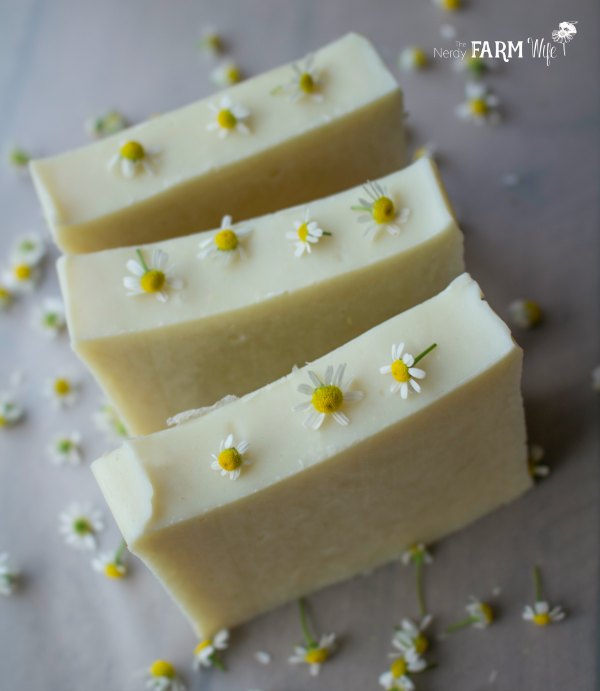 Chamomile adds a soft yellow color plus skin soothing properties. It’s also one of the few flowers that lightly holds its scent during the soapmaking process.
Chamomile adds a soft yellow color plus skin soothing properties. It’s also one of the few flowers that lightly holds its scent during the soapmaking process. 8. Chamomile Soap
Chamomile infused oil can be used for soapmaking too!
Try infusing your olive or coconut oil with chamomile, then use it to make a batch of soap. Depending on the strength of your infusion, it can add a soft yellow tone to the soap.
Virtually all herbs and flowers lose their scent during the soapmaking process, but chamomile is the rare exception in that you’ll sometimes find a light hint of it remaining in the finished soap.
Here are some soap recipes to explore:
- Chamomile “Almost” Castile Soap – super mild, perfect for sensitive skin, made from just olive oil and castor oil
- Chamomile Tea & Honey Shampoo Bars – this soap can be used from head to toe
- Chamomile Carrot Soap – one of my favorite combinations! Find it over at Homespun Seasonal Living.
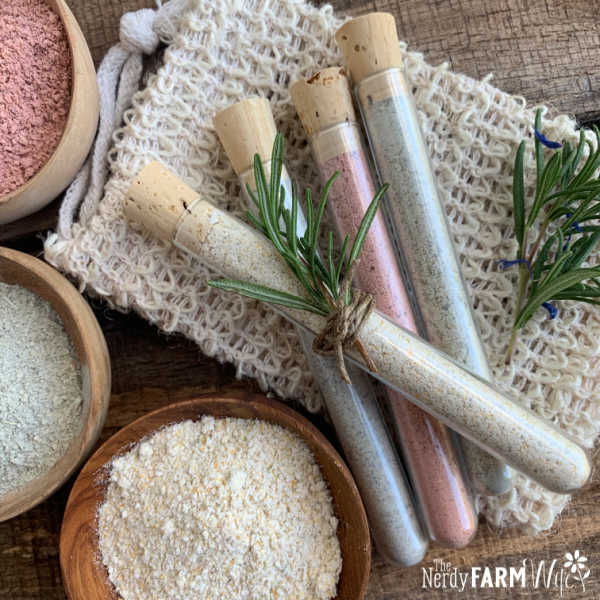
9. Chamomile Rose Cleansing Grains
This is one of four cleansing grain recipes from my print book, The Big Book of Homemade Products for Your Skin, Health & Home. (Shown in the photo above as the tube of pink cleansing grains, in the middle.)
These flower packed cleansing grains gently exfoliate your skin, leaving it feeling soft and smooth.
Ingredients needed:
- 2 tbsp (14 g) rolled oats
- 1/2 tbsp (4 g) milk powder (cow, goat, coconut)
- 1/2 tbsp (0.5 g) dried rose petals
- 1/2 tbsp (0.5 g) dried chamomile flowers
- 1/2 tsp rose kaolin clay
To make: Grind all of the ingredients together in a coffee grinder until finely powdered. Store in an airtight container to keep fresh and dry.
To use: Splash your face with comfortably warm water. Place one or two teaspoons of cleansing grains into your hand and mix with warm water or another liquid (aloe, yogurt, witch hazel, or milk) to form a paste. Gently rub over your face and throat. Rinse well with comfortably warm water and follow with your favorite light moisturizer, if desired. You could also use as a mask, by leaving on your skin for 5 to 10 minutes, before rinsing off.
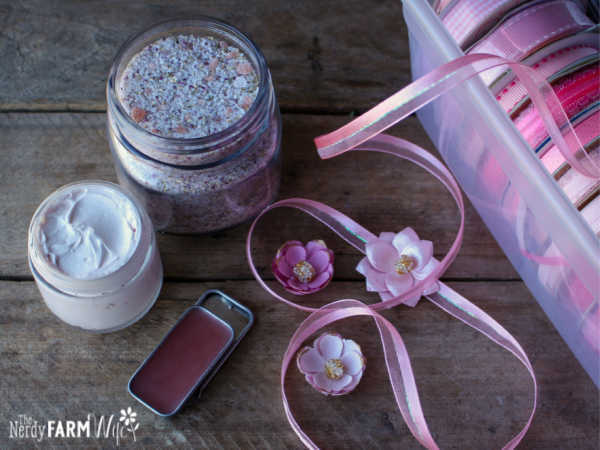
10. Chamomile Rose Lip Balm
This lip balm recipe is from my article, DIY Rose & Chamomile Gift Set. (That article also includes recipes for the whipped hand cream and bath soak, also shown in the photo above.)
Ingredients needed:
- 3.5 tbsp (35 g) oil infused with chamomile (& rose petals if possible)
- 0.5 tbsp (5 g) castor oil (or more infused oil)
- 1 tbsp (14 g) shea or mango butter
- 1 tbsp (10 g) beeswax pastilles (or grated, pressed tightly in the spoon)
- pinch of alkanet root (for color)
- optional: 2 to 3 drops peppermint or sweet orange essential oil
This recipe fills about 7 or 8 lip balm slider tins.
To make: Melt the oils, butter, beeswax, and alkanet root together in a heatproof jar. Once melted, remove from heat and let cool a few minutes. Add a few drops of essential oil, if desired. Pour into slider tins or small round half-ounce tins. If you want to make this lip balm in tubes instead of tins, decrease the oil by around 1 tablespoon.
https://thenerdyfarmwife.com/things-to-make-chamomile/
Terms of Use: The information presented on the network is intended to expand personal knowledge and provide general understanding in a variety of fields to help you be active your Creative freedom and nurturing your health. The information presented here does not pretend to be and is not a substitute for medical instructions. Everything presented on the network is the personal opinion of the writers and any decision regarding your action or health choice is your sole responsibility. with regards For complete inner freedom.
Outhematrix (out the matrix) Network management.



